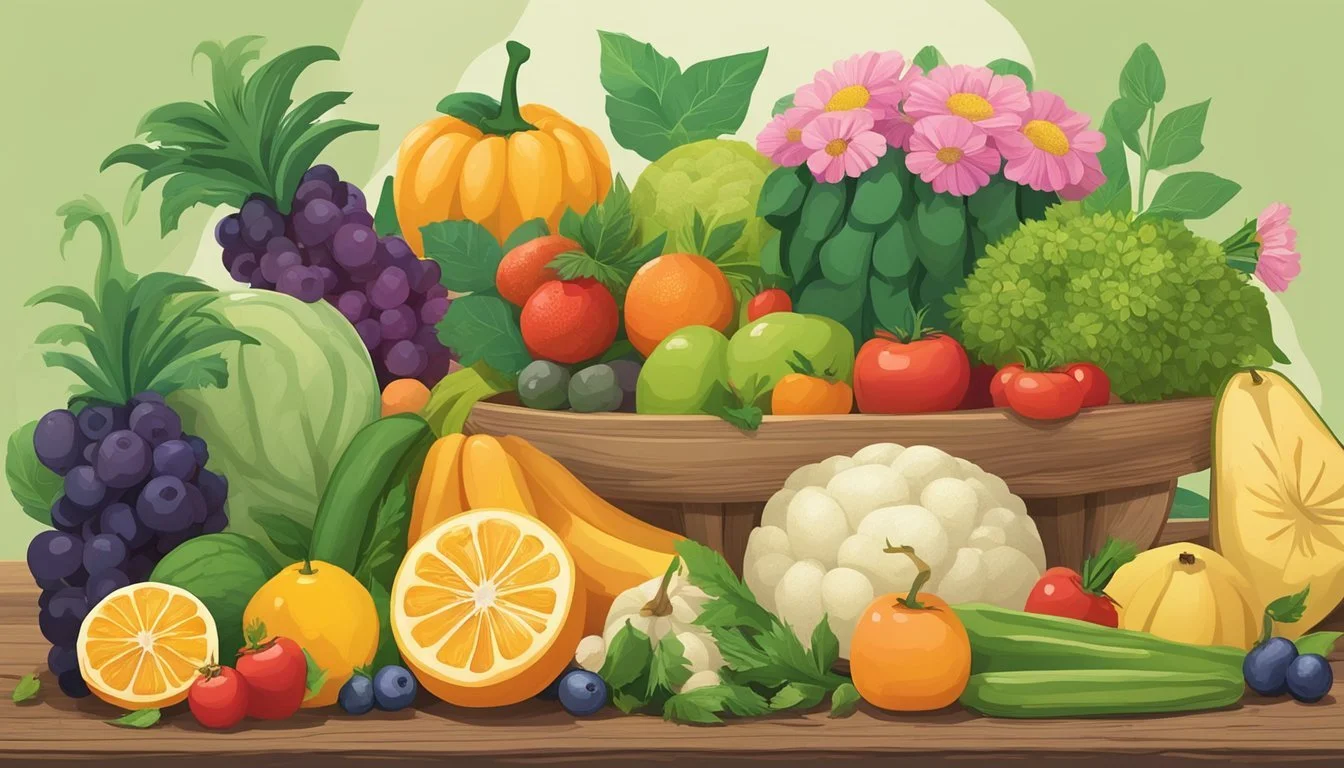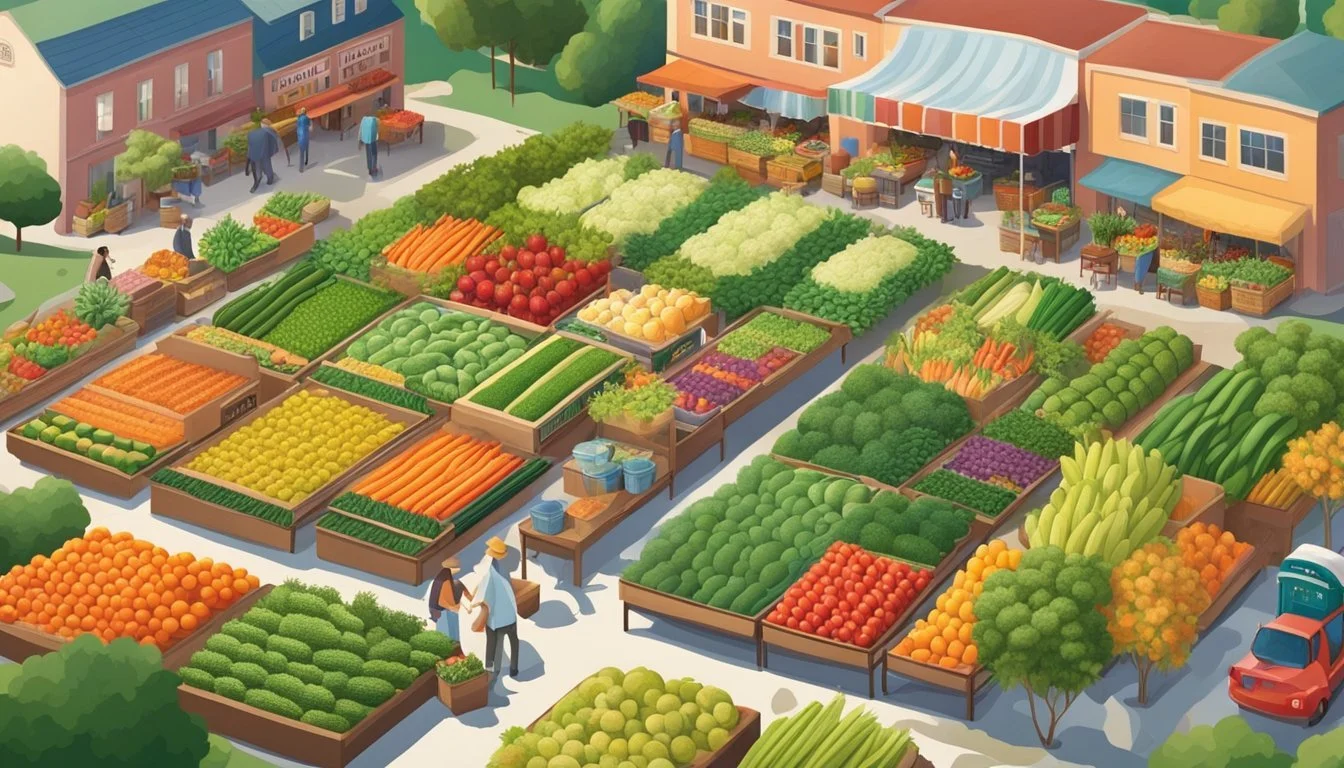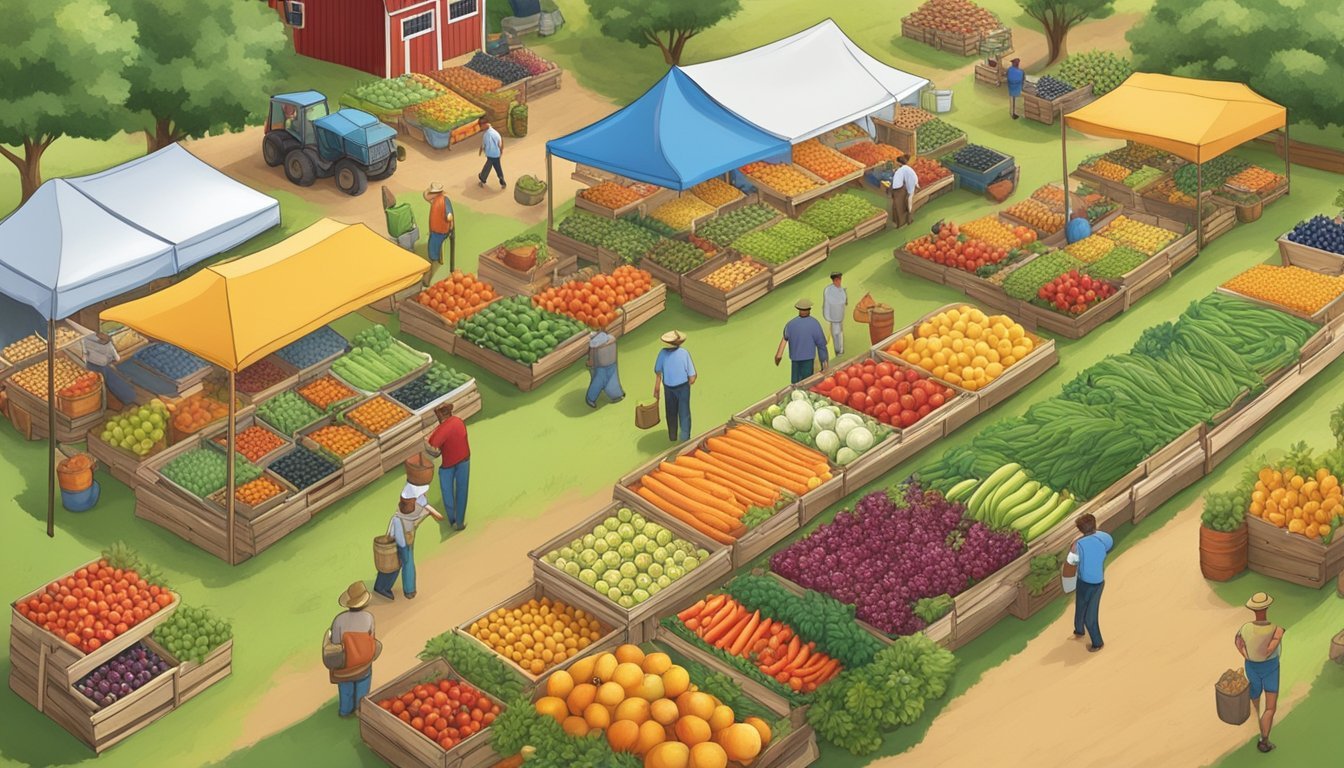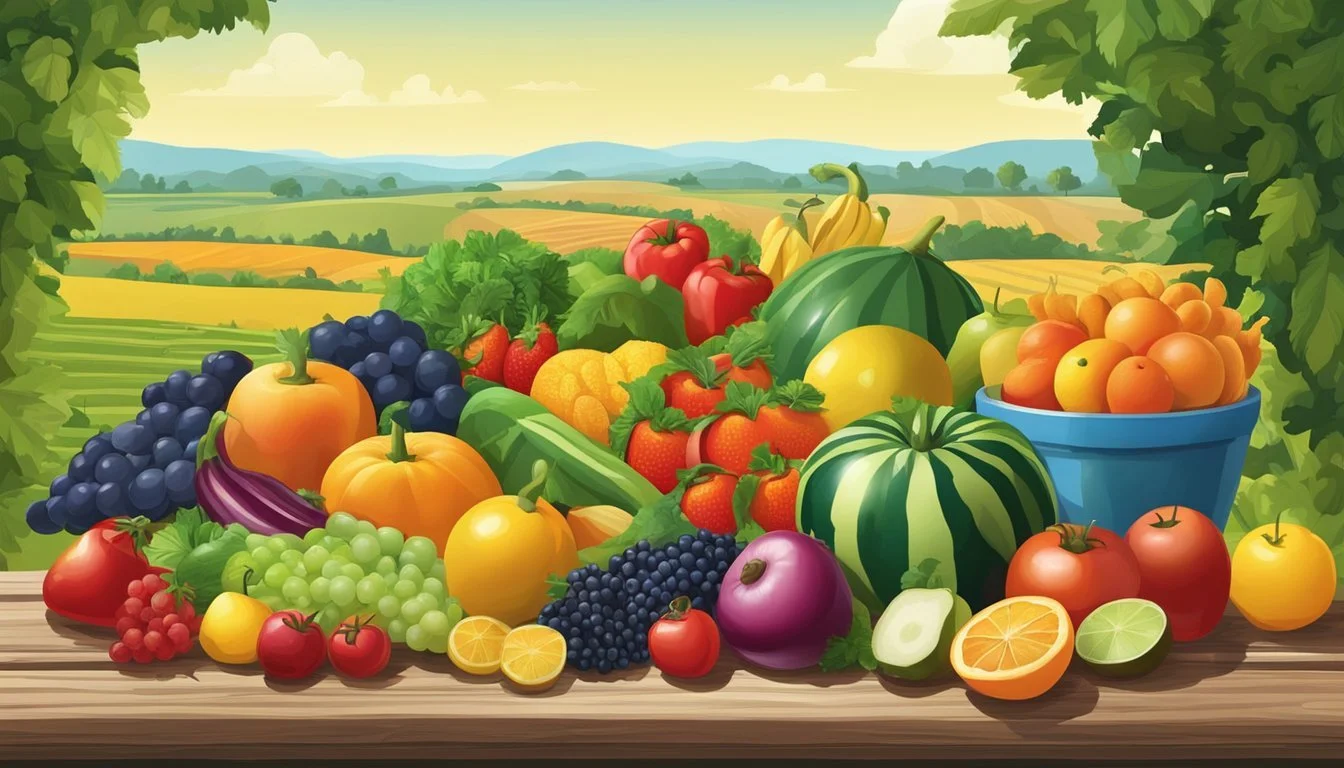Alabama Seasonal Fruit & Veg Guide
Your Essential Calendar
This Article is Part of Our Guide to Seasonal & Local Produce in the USA
Alabama's agricultural landscape offers a rich tapestry of fruits and vegetables that change with the seasons. This natural rhythm dictates the freshest and most flavorful produce available for farm to table dining. Local farms across the state cultivate a wide variety of fruits and vegetables, ensuring that at any given time of the year, a selection of seasonal items can be brought directly from farm to your table.
The Seasonal Farm to Table Fruit & Veg Guide serves as a crucial resource for understanding these patterns. It delineates the peak seasons for Alabama's produce, allowing both consumers and chefs to make informed choices. By aligning their menus and shopping lists with this guide, they can enjoy the freshest fruit and vegetables that have been grown in close proximity to their homes.
Seasonality not only influences flavor but also supports local farming communities. It encourages sustainable agricultural practices by reducing the need for long-distance transportation. When consumers choose seasonal produce from local farms, they enjoy the freshest possible ingredients while contributing to the state's economy and preserving the environment.
What’s in Season in Alabama Right Now?
Understanding Alabama's Seasons
Alabama's diverse climate results in a range of weather conditions favorable to a variety of seasonal produce. The state's harvest seasons reflect these conditions, offering fresh options throughout the year.
Spring Seasonal Produce
In spring, Alabama's weather begins to warm, giving rise to a selection of leafy greens and vegetables. One can find:
Greens: Kale, (What wine goes well with kale?) Lettuce varieties, Spinach (What wine goes well with spinach?), Collard greens
Cruciferous vegetables: Broccoli, Cabbage
Summer Seasonal Produce
Summer in Alabama ushers in hot and humid conditions, ideal for a different set of fruits and vegetables. Key produce includes:
Fruits: Watermelon, Peaches, Blueberries (how long do blueberries last?)
Vegetables: Tomatoes, Sweet corn, Squashes
Fall Seasonal Produce
The fall season provides a moderate climate perfect for the harvest of:
Fruits: Apples (late July through October)
Vegetables: Sweet potatoes (What wine goes well with sweet potatoes?), Pumpkins
Winter Seasonal Produce
The cooler winter weather doesn’t halt production, with cold-tolerant produce still available:
Root vegetables: Turnips, Carrots
Winter greens: Mustard greens, Collard greens
These produce items reflect Alabama's capacity to grow a spectrum of fruits and vegetables, corresponding with the shifting conditions of each season.
Fruits and Vegetables by Season
Alabama's climate allows for a rich variety of fruits and vegetables throughout the year. Each season dictates the freshest produce available, offering flavors at their peak.
Spring Fruits and Vegetables
Fruits:
Strawberries
Blueberries
Vegetables:
Lettuce: Butter, Leaf, Romaine
Spinach
Asparagus (how long does asparagus last?)
Peas: particularly sweet varieties
Broccoli
Kale
New potatoes
Herbs like cilantro and parsley
Summer Fruits and Vegetables
Fruits:
Blueberries
Blackberries
Peaches
Watermelons
Tomatoes: regarded as a fruit botanically
Vegetables:
Summer squash: including zucchini and yellow squash
Cucumbers
Sweet corn
Tomatoes: commonly used as a vegetable in culinary contexts
Peppers: both sweet and hot varieties
Okra
Beans: including green beans and lima beans (how long do lima beans last?)
Eggplants
Fall Fruits and Vegetables
Fruits:
Apples: several varieties
Pears
Muscadine grapes
Vegetables:
Sweet potatoes
Winter squash: acorn, butternut, and spaghetti types
Pumpkins
Cabbage
Kale
Turnip greens
Mustard greens
Winter Fruits and Vegetables
Fruits:
Oranges: including varieties grown in southern Alabama
Vegetables:
Collard greens
Turnip greens
Spinach
Mustard greens
Broccoli
Root vegetables: such as carrots, beets, and radishes
Cabbage
In Alabama, residents have the opportunity to eat locally grown fruits and vegetables that are in season, ensuring maximum flavor and freshness.
Alabama's Agricultural Calendar
Alabama's productive soil and favorable climate conditions establish a robust agricultural calendar that ranges across all four seasons. Farms plan their planting and harvesting schedules to optimize crop yield and ensure a steady supply of fresh, locally grown produce.
Spring marks the onset of the planting season. Growers commence sowing seeds for crops such as strawberries, which herald the arrival of the fruit picking season. Agriculture gears up towards the end of February as soil temperatures rise and the risk of frost diminishes.
Summer in Alabama is when the abundance of farming activity is most evident. A wide variety of vegetables like tomatoes, cucumbers, and corn reach their peak. Orchards become busy with the harvesting of summer fruits such as peaches and blueberries.
Fall is characterized by the harvesting of crops planted in the summer. This season is ideal for hearty vegetables and certain fruits. Apples, for instance, are typically harvested between late July and October, while root vegetables take advantage of the cooling soil.
Winter may seem less active, but it is crucial for preparing the land and setting the stage for the upcoming spring planting. Some greenhouse-grown crops and winter-hardy vegetables are still cultivated and harvested during these colder months.
Here is an overview of the harvest seasons for a sample of Alabama crops:
Season Crops Spring Strawberries, Lettuce, Spinach Summer Tomatoes, Peaches, Blueberries, Corn Fall Apples, Sweet Potatoes, Pumpkins Winter Collards, Turnips
By adhering to this harvest calendar, Alabama ensures a consistent rotation of fresh, nutritious produce across its farms and onto the tables of residents and visitors alike.
Selecting and Storing Produce
When selecting produce, it is essential to look for fresh, vibrant fruits and vegetables indicative of quality and flavor. A buyer should feel confident in their ability to discern ripeness and freshness.
For Cantaloupe, the fruit should feel heavy for its size and possess a sweet fragrance at the blossom end. When storing cantaloupe, refrigerate it after cutting and consume it within a few days for optimal taste.
Kale and Lettuce are best when their leaves are dark-colored and free from brown or yellow spots. These leafy greens should be stored in the refrigerator's crisper, ideally in a plastic bag with air holes to maintain their freshness.
Broccoli should be selected with tight, dark green florets. Preserving its delicious flavor requires refrigerating it quickly. Avoid washing broccoli before storing, as moisture can promote mold growth; instead, rinse it just before use.
Potatoes prefer cool, dark, and well-ventilated storage areas. They keep well in a pantry or cellar, away from onions, as onions release gases that can speed up the spoiling process of potatoes.
Cabbage, another hardy vegetable, is recognized for its tightly packed leaves and should be kept chilled in the refrigerator. It can last for weeks when stored properly.
Here is a brief guide on how to handle these produce items:
Produce Item Selection Tips Storage Suggestions Cantaloupe Heavy for size, aromatic Refrigerate after cutting Kale Dark leaves, no yellow spots Plastic bag in fridge Lettuce Crisp leaves, no discoloration Plastic bag with air in fridge Broccoli Tight, green florets Refrigerate unwashed Potatoes Firm, blemish-free Cool, dark area away from onions Cabbage Compact leaves Refrigerate
This produce guide emphasizes selecting the highest quality products and storing them under optimal conditions to maintain their delicious flavors and nutritional value.
Local Farms and Farmers Markets
Alabama's local farms and farmers markets are vital hubs for fresh, seasonal produce. From March to October, when the weather is typically conducive to an abundant harvest, these establishments are teeming with activity.
Alabama Farmers Market - Birmingham, AL: A cornerstone of local trade, open year-round and particularly favored for its diverse offerings.
Urban Farms – Birmingham: These centers of cultivation provide city-dwellers with fresh options, including Kind Harvest Farm's homegrown seasonal produce.
Local Farms:
Hawkins Homestead Farm: Specializes in Certified Naturally Grown produce, and its CSA program supplies a bounty of fruits and vegetables throughout the prime growing months of April through August.
Kith & Kin CSA: Tailored to feed families with optional add-ons like eggs, this CSA emphasizes freshness in every season.
Monthly Guide to Fresh Finds:
March to May: This period marks the beginning of the planting and growth season, with early crops arriving at the markets.
June to July: The peak of summer ushers in a wide variety of fruits and vegetables, with local farms often offering the freshest picks.
August to October: As summer fades, Alabama's harvest is in full swing, with farmers delivering an array of fresh produce before the growing season ends.
Local farmers and markets are integral to the community, providing access to fresh, nutritious food while supporting the state's agricultural economy. They are steadfast in their commitment to offering the freshest produce each season.
Farm to Table Movement in Alabama
The Farm to Table movement in Alabama celebrates local farms, underscores the value of sustainable agricultural practices, and ensures access to healthy food. This culinary and cultural initiative thrives on Alabamians' deep-rooted connection to the land and their recognition of the benefits that fresh, locally sourced produce brings to their tables.
Local initiatives such as Sweet Grown Alabama’s annual Farm to Table dinner highlight the state's commitment to this movement. They showcase the importance of supporting Alabama growers and the significance of the state's agricultural heritage. By participating in such events, residents reinforce the farm to table loop, stimulating local economies and reducing environmental impacts.
Season Fruits Vegetables Spring Strawberries Lettuce Summer Peaches Tomatoes Fall Apples Squash Winter Pears Sweet potatoes
The table above provides a glimpse into the seasonal produce one might expect from Alabama farms. This state, known for its fertile soil, yields a variety of fruits and vegetables that benefit from the regional climate, including staple crops like peanuts. These crops find their way into local restaurants and homes, with a story of local heritage and meticulous care that industrial food chains seldom match.
Organizations like EAT South in Montgomery foster the Farm to Table movement through education and transforming the community's approach to food. They advocate for the movement by engaging with the public on the values of local, sustainable, and healthy eating options. This advocacy is pivotal for maintaining the health and sustainability ethos that Alabamians are increasingly embracing.
Supporting Local Agriculture
Supporting local agriculture in Alabama can be immensely beneficial to the community, environment, and economy. Local farmers markets and Community-Supported Agriculture (CSA) programs provide residents the opportunity to purchase fresh produce directly from local growers. Typically, these local marketplaces create a space where consumers can engage with farmers, fostering a sense of community and a deeper understanding of where their food originates.
Alabama's fertile soil and diverse climate contribute to a variety of fruits and vegetables that flourish seasonally. By purchasing these local goods, individuals support the sustainability and vitality of these farmlands. CSAs are also proactive in bringing farm-fresh produce to Alabama consumers, with various programs offering full or half-season shares delivered weekly or bi-weekly.
Social media platforms, such as Facebook and Pinterest, play a vital role in supporting these local agricultural efforts. They are effective tools for sharing information, connecting consumers with local farms, and promoting events in cities such as Montgomery. CSAs and farmers frequently use these platforms to communicate with customers, update them on seasonal offerings, and spread awareness about the advantages of farm-to-table produce.
Below is a tabulated guide highlighting produce available during different seasons in Alabama:
Season Fruits & Vegetables Spring Strawberries, Lettuces Summer Peaches, Tomatoes Fall Apples, Sweet Potatoes Winter Collards, Winter Squash
By engaging with local agricultural initiatives, members of the community help to ensure the stability and growth of Alabama farms, contributing to a sustainable and resilient food system.
Seasonal Recipes and Cooking Tips
With an abundance of fresh produce, Alabama offers a seasonal palette for culinary exploration. Chefs and home cooks alike can take advantage of flavorful fruits and vegetables at the peak of their freshness. The key is to select ingredients when they are in season to maximize taste and nutritional value.
Spring: In March, bright citrus and leafy greens are widely available. They recommend incorporating juicy oranges into a citrus salad or using fresh spinach in a vibrant quiche.
Summer: Utilizing seasonal fruits such as cantaloupes and watermelons can add a refreshing touch to any meal. They suggest crafting a chilled melon soup or a watermelon, feta, and mint salad.
Season Suggested Produce Recipe Ideas Spring Strawberries, Asparagus Strawberry spinach salad, grilled asparagus (What wine goes well with grilled asparagus?) Summer Peaches, Tomatoes Peach salsa, Caprese salad (What wine goes well with caprese salad?)
For a hearty fall dish, they encourage roasting seasonal vegetables like butternut squash with a drizzle of olive oil and a sprinkle of fresh herbs. This not only brings out the natural sweetness of the squash but also provides a comforting, delicious option for cooler evenings.
In the winter, chefs often turn to root vegetables, which store well and offer robust flavors. A parsnip and carrot mash or a beetroot and goat cheese tart can both celebrate these seasonal offerings.
When cooking, remember to use herbs and spices to complement the natural flavors of the produce. Fresh basil, for example, can heighten the taste of a tomato, while a touch of cinnamon can enhance the sweetness of apples.
By focusing on seasonal produce, they ensure that the food on the table is not only delicious but also imbued with the true taste of Alabama's seasonal bounty.
Additional Local Products
In addition to a rich variety of fruits and vegetables, Alabama boasts an array of local products that are staples in farm to table dining experiences. Meat is a significant component, with farmers across the state raising cattle, poultry, and pigs, ensuring a supply of fresh, locally-sourced beef, chicken, and pork.
Eggs from free-range chickens are readily available, valued for their freshness and taste compared to mass-produced alternatives. They represent the commitment to quality and sustainability that Alabama's farmers are known for.
Local honey is another treasured product, with beekeepers maintaining hives to support not just the production of honey but also to aid in the pollination of crops. The state's honey varies in flavor, influenced by the blossoms from which the bees collect nectar, reflecting the unique terroir of each locale.
When it comes to nuts (how long do nuts last?), Alabama offers pecans (how long do pecans last?) and peanuts, which are not only delightful to snack on but also serve as essential ingredients in Southern cooking. Pecans, in particular, are harvested in the fall and are a highlight in various desserts and savory dishes.
The state's fields are also dotted with vibrant flowers, including both wildflowers and cultivated varieties, which are often sold at local farmers' markets or used by florists for arrangements that embody the essence of Alabama.
Lastly, muscadines, a type of grape native to the Southeastern United States, thrive in Alabama's climate. These grapes are typically harvested in late summer and are known for their distinct, sweet flavor, making them a favorite for fresh consumption, wines, and jellies.
Conclusion
Alabama's climate fosters a diverse agricultural landscape, enabling farmers to provide a broad variety of seasonal produce. Consumers seeking sustainable and healthy food choices have access to fresh, locally-grown fruits and vegetables throughout the year. By aligning their consumption habits with the seasonal availability of produce, they not only enjoy peak freshness and flavor but also support local agriculture and reduce environmental impact associated with long-distance food transportation.
Seasonal Highlights:
Spring: A time of vibrant greens, spring in Alabama brings an abundance of leafy vegetables to the table.
Kale
Spinach
Lettuces (butter, leaf, romaine)
Summer: The warm months are rich with juicy fruits and robust vegetables.
Strawberries
Tomatoes
Peppers
Fall: The harvest yields heartier selections befitting the cooler weather.
Apples (late July through October)
Root vegetables
Winter: Even in the colder months, options remain for locally sourced produce.
Collard greens
Turnip greens
Farmers' markets, roadside stands, and community-supported agriculture (CSA) programs offer gateways to these nutritious food sources. By choosing local and seasonal produce, individuals contribute to a sustainable food system, promote economic stability within their communities, and gain the health benefits of fresh, nutrient-rich foods.












